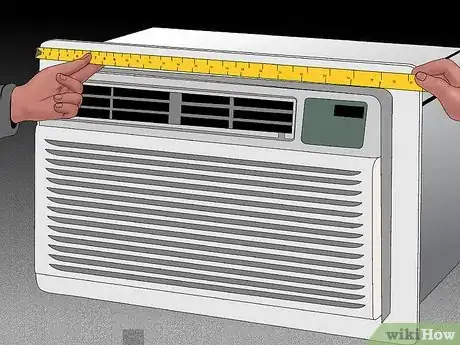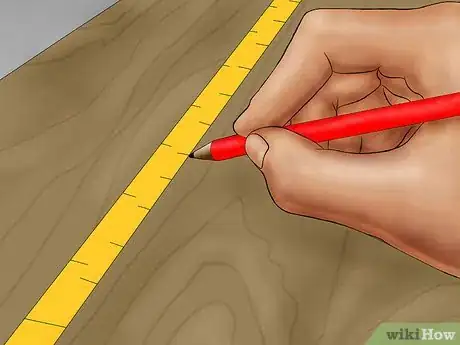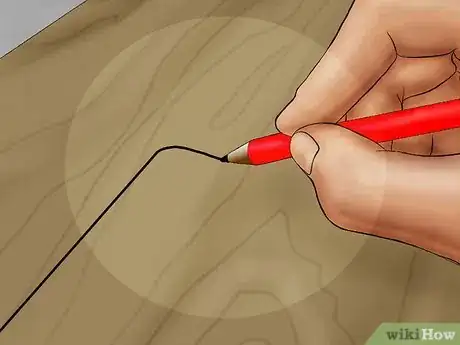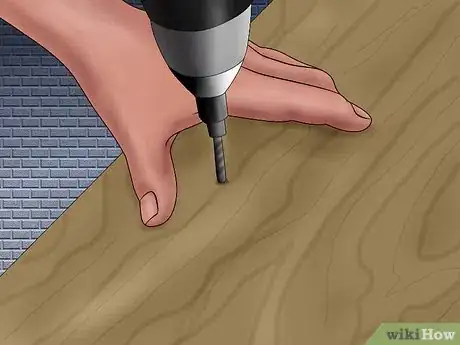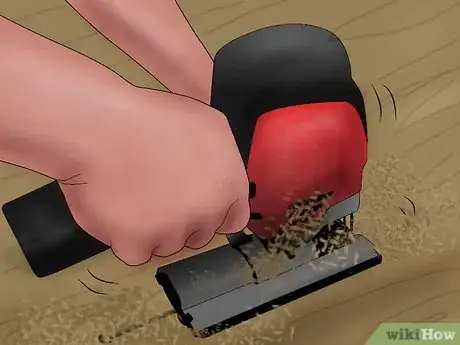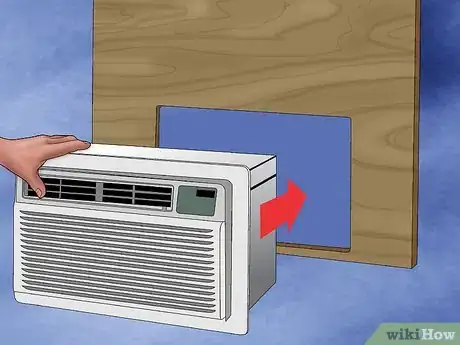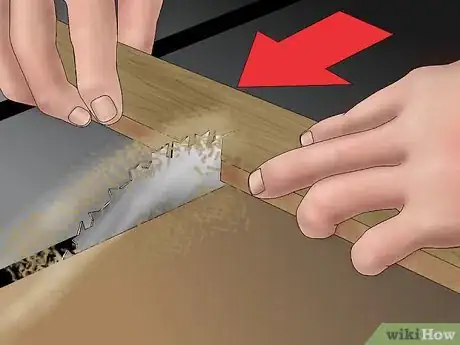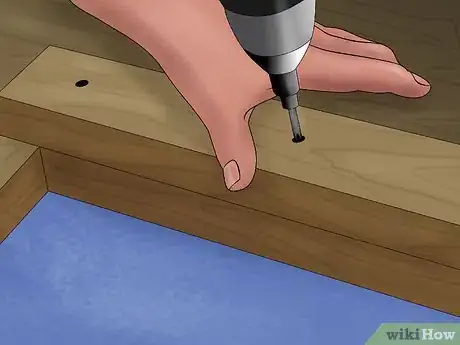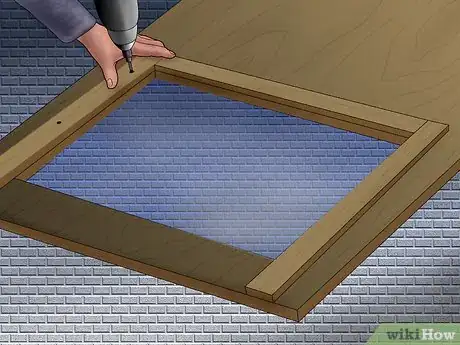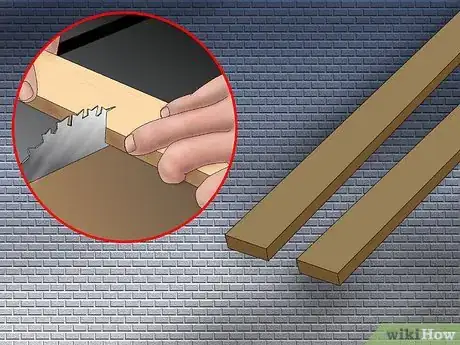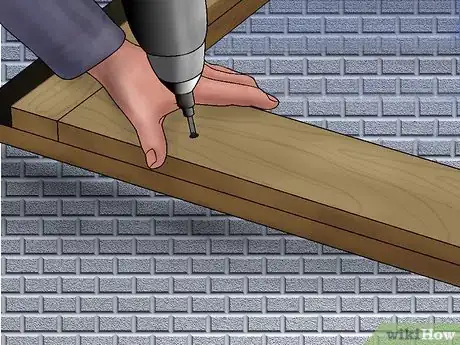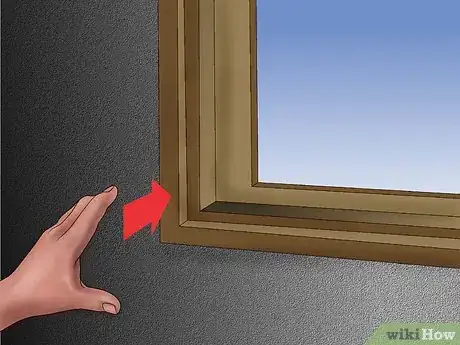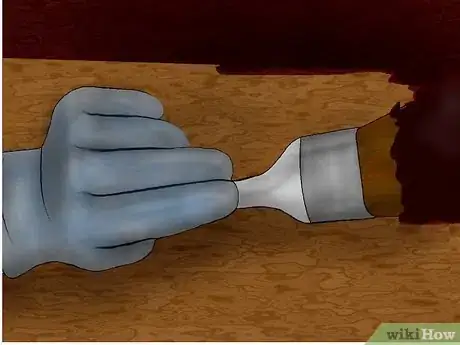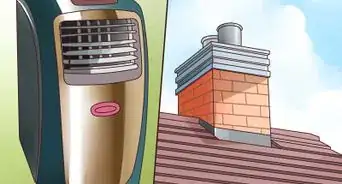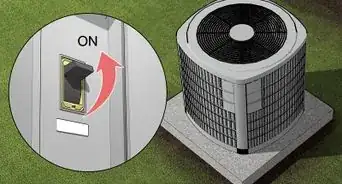wikiHow is a “wiki,” similar to Wikipedia, which means that many of our articles are co-written by multiple authors. To create this article, volunteer authors worked to edit and improve it over time.
There are 10 references cited in this article, which can be found at the bottom of the page.
This article has been viewed 58,646 times.
Learn more...
Air conditioning is the ultimate luxury on a hot summer day. With the flip of a switch, you can cool down your house and relax in a cold breeze. However, if you have irregular windows in your house, you may not be able to use standard AC units. If you want to use a standard AC unit in your windows, you can create a wooden mounting box to accommodate your unit and make sure it doesn't fall out of your window.
Steps
Creating the Backplate
-
1Measure the width of the window to know how wide your backplate should be. Prior to cutting any wood, make sure you correctly measure the width of your window to ensure that you create a backplate of the appropriate dimensions.
- Don't measure the entire open space of the window, rather, measure from the first inner lip on the interior frame of the window.
- Do this to ensure that your built box overlaps the window frame, rather than falls through it.
- This flush (even edges) construction also makes sure that the window remains weather-sealed.
- Make sure your measurements account for any abutting vinyl ridges or channels within the window frame.
-
2Double check your measurements to be safe before cutting. Prior to using any power saws, ensure that your measurements are exact and that you are safe from any debris or wood chips.
- If your measurements are not exact, your entire box will be a waste of effort.
- Follow the old adage: measure twice, cut once.
- Mark your measurements on your plank of wood, drawing out lines that indicate the height and width of your backplate.
Advertisement -
3Cut your wood piece to fit the window. Following the lines you marked, use your saw to cut your plank of wood down to a size that will fit perfectly in your window.
- Choose a track saw to ensure your line is as clean and straight as possible.[1]
- If you do not have a track saw available, you can use a regular circular saw.[2]
- Be aware that using a circular saw will be more difficult and result in a more uneven cut.
- Save the excess wood, because it is the same length as your backplate and can be used later.
- Wear safety goggles to protect your eyes from any flying wood particles.
-
4Measure the air conditioning unit. Measure the width and the height of the air conditioning unit to know how large of a hole you will need to cut in the backplate.
- Measure the width at its widest consistent point, not where the sides of the unit begin to curve in towards its face.
- Take any pieces jutting off of the unit into consideration to provide enough clearance.
- This will make sure the unit can pass through the opening of the box you will create.
- Take measurements of the flanges on the bottom and top, because your wood panels will need to incorporate two indented portions to accommodate the flanges and secure them in place.
- Pencil these measurement marks onto your backplate with a carpenter's square and straightedge to make sure you have lines to follow when cutting.
-
5Add up your measurements and wood widths mathematically to ensure the correct dimensions for the box. Using the measurements you took from your AC unit and the widths of your boards, find the proper cutting dimensions for your wood.
- For example leave 3-1/4 inches at the top to catch the window and clear the flange, 11-3/8 for the height of the unit, and then 1-1/2 at the bottom for the lip. This makes a total of 16-1/8 inches for the weight of the cut hole.
- Add a little to ensure clearance, bumping up the cutting measurement to 16-1/2.
- Mark your wood with a pencil at 16-1/2 on both sides of the wood to align the track for the saw.
-
6Draw a diagram on your wood, of the hole that will accommodate your AC unit, to guide your cut. Trace the lines where you will cut, along the straight edge, to ensure that you will cut at the proper places.
- Make sure your measurements are accurate, using a straight edge and carpenter's square to align the measurements on both sides of the wood.
- If you ever realize that you made a mistake in the measurements, be sure to erase your old lines to avoid following them with the saw.
-
7Drill holes in the corners of your diagram to accommodate the jigsaw blade. Drilling holes in the corners of where you want to cut out the center of your backplate allows the jigsaw blade to get started without cutting in from the side.
- You can't cut in from the side, because that would cut an entire piece off of the wood that you need.
-
8Cut out the center of the backplate, from pilot hole to pilot hole. Insert your jigsaw into the first pilot hole and follow your traced line to cut out the box from your backplate.
- Hold the jigsaw steady to ensure a clean line.[3]
- Jigsaws have a tendency to “walk”, meaning they can start moving in other directions if you aren't careful.
- If you have a track saw, use that for a cleaner, more stable cut.
Attaching the Catches
-
1Place your backplate over the air conditioner to make sure it fits. To determine whether or not you need to make measurement adjustments, put your backplate over your AC unit and see if it bumps anything.
- If anything sticks, or if the AC unit doesn't fit at all, you know you need to cut a bit more from the backplate's interior edges.
-
2Cut the horizontal window catch that will house the AC's flange. The horizontal window catch is a narrow strip of wood that will abut the lower edge of the window's sliding portion, to lock the box in place.
- Use your carpenter's square and straightedge to measure out a strip that will be attached the backplate to provide a ridge accommodating the flange on the top of the AC unit.
- If you have a table saw, set it to a fenced 1-1/2 inches and cut the strip.[4]
- Then, use a miter saw to cut the strip down to the length of your frame.[5]
- This strip will be sandwiched between the backplate of your box and the vertical window catch, to provide an area for the window to lodge in.
-
3Attach the horizontal window catch. Using the previously drawn line that represents the flange, align the strip you just cut with its proper location on the backplate.
- Make sure the strip you cut for the flange and the box's backplate are even.
- Clamp the strip to the backplate to ensure easy attachment.
- On the backplate's edges, mark the location where the screws will go.
- Use a countersink bit to create a clean pilot hole for the screws and add a taper to let head of the screws fit flush against the wood.
- Once you've drilled the pilot holes, drive screws into the wood to attach the strip to the backplate.
-
4Add the vertical window catch to complete the channel for the window. The vertical window catch will ensure that the box cannot simply fall backwards and out of the window.
- Cut a piece of wood, equal in length to the horizontal window catch, but wider, to act as the back of the channel.
- Drill pilot holes through the vertical window catch, to the horizontal window catch you just attached.
- Space the pilot holes roughly every 6 inches (15.2 cm), and leave an inch or so at the end to provide clearance space.
- Look on the opposite side to make sure you won't hit any of your other screws.
- Use screws to attach the vertical window catch to the horizontal window catch.
-
5Cut two pieces of wood to catch the box against the plastic piece within the bottom of the windowsill. These pieces will make sure that that the bottom of the box fits snugly and securely in the bottom of the window.
- Measure and cut a piece of wood that will act as a gap bridger (spacer), between the backplate and the sash filler.
- This piece should provide just enough clearance for the sash filler to lock into the bottom channel of the window.
- Then measure and cut a sash filler (a small piece) that will hook inside the bottom plastic lip of the windowsill.
- Use your track saw for a clean cut.
- Make sure the piece of wood is thick enough to catch the lip or nub on the inside of the bottom of the windowsill.
- Measure and cut a piece of wood that will act as a gap bridger (spacer), between the backplate and the sash filler.
-
6Attach the gap bridger and sash filler to the bottom portion of the backplate. Use screws to attach this pieces to the bottom.
- Attach the gap bridger directly to the bottom of the backplate, and then attach the sash filler on top of that.
- Make sure that the screws have at least a half-inch of bite, which will ensure that they stick properly.
- Now, your box should be complete.
Finishing the Box
-
1Place your box in the window to ensure a snug fit. When placing the box into your window, make sure that it fits flush and does not wiggle or fall out.
- Remove the screen before placing your box into the window frame.
- The sash filler you built into the bottom your box should accommodate the ridges of the windowsill, fitting together like two pieces of a puzzle.
- The catch on the top of your box (created by the vertical and horizontal window catches) should provide a snug place for the bottom edge of the window to slide down into.
-
2Attach the AC unit to the box with a single screw. If the box fits well in the window, you can now secure your AC unit to the box.
- On the top flange of the AC unit, there should be a single hole meant for one screw.
- This is usually used to attach the AC unit to the window frame, but in this case you should put a screw through the hole into your box.
-
3Fill the screw holes in with Spackle. Using a putty knife, smooth some Spackle over the screw holes to make them look natural and flush.[6]
- Make the holes smooth with a putty knife.
- Let it dry.
- Sand it down to make it smooth.
-
4Caulk the edges to provide a seal against outside air. Fill the edges with caulking to provide a seal against drafts and to keep your cold air in your house.[7]
- Caulking the edges makes sure that the AC unit does not leak air.
- Make sure you want to keep the AC in the box before you caulk, because this can make it a semi-permanent fixture.
-
5Prime every surface of the wood to make the box weatherproof. Priming and painting the box will make sure that it can withstand the test of time.[8]
- Let the primer dry for an hour if there is low air humidity.
- This will make sure that rain and humidity do not rot your wood box.
References
- ↑ https://bestofmachinery.com/how-to-use-a-track-saw/
- ↑ https://www.lowes.com/n/how-to/how-to-use-a-circular-saw
- ↑ https://www.bobvila.com/articles/how-to-use-a-jigsaw/
- ↑ https://www.bobvila.com/articles/how-to-use-a-table-saw/
- ↑ https://www.lowes.com/n/how-to/how-to-use-a-miter-saw
- ↑ https://www.bobvila.com/articles/how-to-spackle-exterior-siding/
- ↑ https://www.lowes.com/n/how-to/how-to-caulk
- ↑ https://www.artofmanliness.com/articles/basics-finishing-wood/
- https://www.countryliving.com/gardening/g4475/hide-air-conditioner-unit/
About This Article
Making a wooden box for your air conditioning unit will help to house it and make sure it doesn’t fall out of your window. To make your box, you’ll need a big piece of plywood and 5 strips of wood. First, measure the height and width of your unit, then cut out a hole for your unit in the bottom of your plywood. Add an extra quarter inch on all sides to make sure your unit fits. Once you’ve cut out the hole, cut 1 ½ inch thick wood strips to form a border around it and screw them to the plywood. Attach your air conditioning unit to the box with a single screw, then prime and paint the wood to make it weatherproof. For more tips, including how to seal your wooden box to your window, read on!



